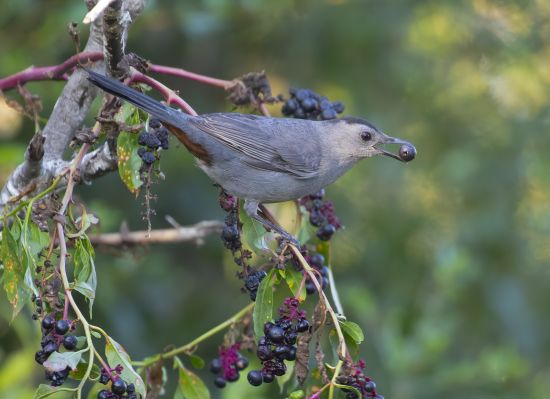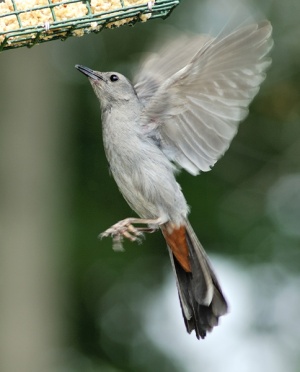- Dumetella carolinensis
Identification
8-9 inches (21-24 cm)
Smaller than American Robin
- Dark gray
- Black cap
- Rusty undertail coverts
- Slender, long-tailed
Distribution
Breeding
North America: from British Columbia, Manitoba, and Nova Scotia south to Washington, Texas, and Georgia.
Non-breeding
From Carolinas and Gulf Coast southward, small numbers occur regularly to southern New England.
Taxonomy
This is a monotypic species[1].
Formerly known as "Catbird," this bird has had its name changed officially to Gray Catbird because there is an all-black species, the Black Catbird in southern Mexico.
Habitat
Thickets and brush, residential areas and gardens.
Behaviour
A ground feeder, turning the leaf litter over with the beak
Breeding
The bulky nest is hidden in bushes or vines. Four or five shiny blue-green eggs are laid
Diet
Consists of insects and fallen berries
Vocalisation
Song: A long, irregular succession of musical and mechanical notes and phrases. Sometimes seems to mimic other birds.
Call:
- Cat-like mewing
- Ratchett call when alarmed
- Soft whip and chip given at nest between pairs.
References
- Clements, J. F., T. S. Schulenberg, M. J. Iliff, D. Roberson, T. A. Fredericks, B. L. Sullivan, and C. L. Wood. 2018. The eBird/Clements checklist of birds of the world: v2018. Downloaded from http://www.birds.cornell.edu/clementschecklist/download/
- Handbook of the Birds of the World Alive (retrieved May 2014)
Recommended Citation
- BirdForum Opus contributors. (2025) Gray Catbird. In: BirdForum, the forum for wild birds and birding. Retrieved 1 May 2025 from https://www.birdforum.net/opus/Gray_Catbird
External Links
GSearch checked for 2020 platform.1






